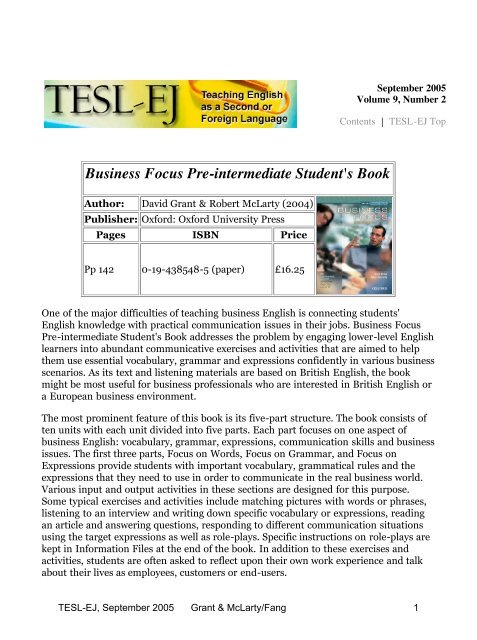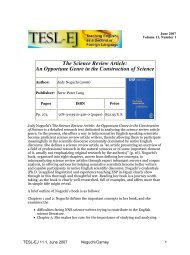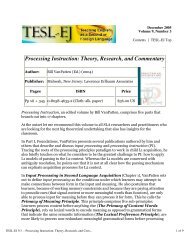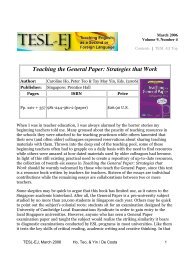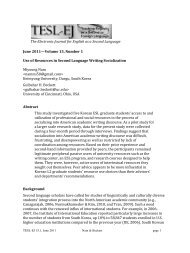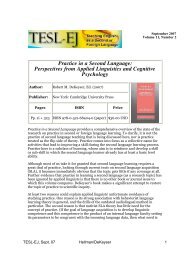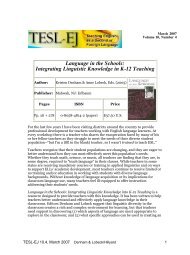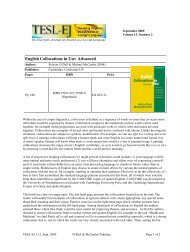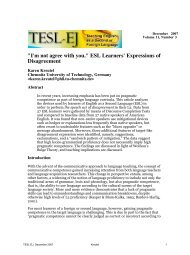TESL-EJ 9.2 --Business Focus Pre-intermediate
TESL-EJ 9.2 --Business Focus Pre-intermediate
TESL-EJ 9.2 --Business Focus Pre-intermediate
You also want an ePaper? Increase the reach of your titles
YUMPU automatically turns print PDFs into web optimized ePapers that Google loves.
September 2005Volume 9, Number 2Contents | <strong>TESL</strong>-<strong>EJ</strong> Top<strong>Business</strong> <strong>Focus</strong> <strong>Pre</strong>-<strong>intermediate</strong> Student's BookAuthor: David Grant & Robert McLarty (2004)Publisher: Oxford: Oxford University <strong>Pre</strong>ssPages ISBN PricePp 142 0-19-438548-5 (paper) £16.25One of the major difficulties of teaching business English is connecting students'English knowledge with practical communication issues in their jobs. <strong>Business</strong> <strong>Focus</strong><strong>Pre</strong>-<strong>intermediate</strong> Student's Book addresses the problem by engaging lower-level Englishlearners into abundant communicative exercises and activities that are aimed to helpthem use essential vocabulary, grammar and expressions confidently in various businessscenarios. As its text and listening materials are based on British English, the bookmight be most useful for business professionals who are interested in British English ora European business environment.The most prominent feature of this book is its five-part structure. The book consists often units with each unit divided into five parts. Each part focuses on one aspect ofbusiness English: vocabulary, grammar, expressions, communication skills and businessissues. The first three parts, <strong>Focus</strong> on Words, <strong>Focus</strong> on Grammar, and <strong>Focus</strong> onExpressions provide students with important vocabulary, grammatical rules and theexpressions that they need to use in order to communicate in the real business world.Various input and output activities in these sections are designed for this purpose.Some typical exercises and activities include matching pictures with words or phrases,listening to an interview and writing down specific vocabulary or expressions, readingan article and answering questions, responding to different communication situationsusing the target expressions as well as role-plays. Specific instructions on role-plays arekept in Information Files at the end of the book. In addition to these exercises andactivities, students are often asked to reflect upon their own work experience and talkabout their lives as employees, customers or end-users.<strong>TESL</strong>-<strong>EJ</strong>, September 2005 Grant & McLarty/Fang 1
<strong>Focus</strong>ing on building students' communication abilities rather than linguistic accuracy,the book does not give explicit lengthy instructions on vocabulary, grammatical rules orexpressions. Instead, it provides a summary of key words, grammar and expressionspresented in small pink boxes at the end of each section. However, if students encounterany new words in the text, they can look them up in the Glossary at the end of the book.In the same way, if students want to read more about a particular grammatical issue,they can consult Language Reference, also at the end of the book. Besides 16grammatical topics, including present, past, and future tenses, countable anduncountable nouns, comparatives and superlatives, 1st and 2nd conditional, and modalsof obligation and permission, Language Reference also contains six topics of usefullanguage and expressions, which are useful for students' role-plays and other outputactivities.The fourth part of each unit, <strong>Focus</strong> on Communication, requires students to producecohesive written or spoken passages while participating in task-based activities, such aswriting emails to confirm an appointment, conversing in a small talk with colleagues,giving a short presentation or discussing a topic in a meeting.The last part of each unit, <strong>Focus</strong> on <strong>Business</strong> Issues, expands the main topic of eachunit by addressing more specific business issues, such as making good businesscontacts, entertaining clients, and choosing the right job. This part requires students tointegrate the vocabulary, grammar, and expressions they have learned in previous partsto understand and talk about various business issues.At the end of each unit, a short End-of-Unit quiz is included. Students can use it to testtheir knowledge of the vocabulary, grammar, and expressions they have just learned.Besides Language Reference, Glossary, and role-play files as described above, one canalso find two other appendices, an Irregular Verb List and Tapescript of all the listeningactivities at the end of the book.In general, the organization of this book is cohesive and easy to follow. The languageknowledge taught in the first three parts provides solid foundations for students toparticipate in more challenging communicative activities in <strong>Focus</strong> on Communicationand <strong>Focus</strong> on <strong>Business</strong> Issues. The summaries of key words, grammar and expressionsat the end of each unit and the appendices at the end of the book give studentsappropriate support for their self-study and review.The materials used in this book closely relate to the real business field. The book usesexamples of famous companies, such as Xerox, Gap, and Yahoo. It also covers currenttopics in the business world, such as "doing business in different cultures," "thepaperless office," "teleworking,"and "speed-dating." The book tries to expose students toa variety of English materials including graphs, notes, minutes, advertisements, and jobinterviews that are common in a work place. Some materials used in the book areauthentic; they are selected from English newspapers, magazines or the Internet. Some<strong>TESL</strong>-<strong>EJ</strong>, September 2005 Grant & McLarty/Fang 2
materials were adapted in order to suit the English level of the target readers. Thelistening materials were recorded for readers of the book particularly; however, thespeech sounds natural and reflects real-life situations. The overall appearance of thebook is also pleasant with user-friendly display of materials. Each part of a unit andappendix is labeled to help readers search for specific information.Along with this book, there is a free video phrasebank including video clips ofworkplace interactions, a collection of useful email phrases, and a unit-by-unit audiowordlist. The picture quality of the video and the sound quality of the audio wordlist areexcellent. In addition, free online resources including interactive exercises onvocabulary, grammar and expressions, supplementary reading materials, and languagegames are also available to anyone who wants to learn more. Teachers can also find freeteaching materials including handouts and extra activities on the course webpage. Withits rich supplementary materials, <strong>Business</strong> <strong>Focus</strong> <strong>Pre</strong>-<strong>intermediate</strong> Student's Book isideal for ESL and EFL learners as well.Fang FangMichigan State University© Copyright rests with authors. Please cite <strong>TESL</strong>-<strong>EJ</strong> appropriately.Editor's Note: The HTML version contains no page numbers. Please use the PDFversion of this article for citations.<strong>TESL</strong>-<strong>EJ</strong>, September 2005 Grant & McLarty/Fang 3


